Jiefangbei (Liberation Monument) is located in the center of Jiefangbei Commercial Pedestrian Street, Yuzhong District, Chongqing. It is one of the seventh batch of national key cultural relics protection units and one of the "Top Ten New Cultural and Tourism Landmarks in Chengdu-Chongqing". Its characteristic is that it is the only monument in China commemorating the victory of the Chinese nation in the War of Resistance against Japanese Aggression, and also a spiritual symbol of the victory of the War of Resistance, carrying the collective memory of the people of Chongqing and serving as the image symbol of Chongqing. Jiefangbei is a reinforced concrete structure with an octagonal shape and a helmet-shaped top, standing 27.5 meters high. It consists of 8 parts: the pedestal, the body, the standard clock, the observation platform, the alarm bell, the lighting system, the wind vane, and the commemorative steel pipe. The pedestal is built with bluestone, covering an area of 642 square meters. The 8 steps above are a terrazzo platform with a diameter of 20 meters. A prosperous commercial circle has formed in the surrounding area centered on Jiefangbei, but there is no clear data on the area of the scenic spot.
Historical Culture
On March 12, 1940, the anniversary of Sun Yat-sen's death, the construction of the monument began. It was then named "Spiritual Fortress" to inspire the Chinese people to strive for victory in the War of Resistance. On December 30, 1941, the "Spiritual Fortress" was officially completed. After the victory of the War of Resistance in 1945, it was decided to build the "Monument to Commemorate the Victory of the War of Resistance" on the former site of the "Spiritual Fortress". The foundation of the monument was laid on October 31, 1946, and it was completed and inaugurated on October 10, 1947. The inscription "Monument to Commemorate the Victory of the War of Resistance" was carved on the monument, with a total cost of 202 million yuan (old currency). In September 1949, it was renamed "People's Liberation Monument", with the inscription written by Liu Bocheng, then Chairman of the Southwest Military and Political Commission. Jiefangbei has witnessed the historical changes of Chongqing from the period of the War of Resistance to after liberation, embodying the indomitable national will of the people in the rear area, and is a monument symbolizing perseverance in the war and the bloody struggle of the whole nation.
As the most historically significant commercial district in Chongqing, the area around Jiefangbei retains some architectural styles from the Republic of China period, such as the old sites of banks and shops during the War of Resistance. These, together with modern high-rise buildings, form a unique urban landscape, reflecting the integration of Chongqing's history and modernity.
Main Attractions
People's Liberation Monument
People's Liberation Monument is located at No. 177 Minzu Road, Yuzhong District, Chongqing. It is an octagonal cylindrical helmet-top reinforced concrete structure, 27.5 meters high. The 8 sides of the pedestal are decorated with reliefs and inscriptions, including the full text of the National Government's designation of Chongqing as the temporary capital. A standard clock is installed on each of the 4 sides of the monument body at a height of 23 meters, and the alarm bell is set at the highest part of the monument body. Facing Minzu Road is the front side, engraved with 7 gilded characters "Monument to Commemorate the Victory of the War of Resistance", with the signature "October 31, 1946, Zhang Dulun, Mayor of Chongqing".
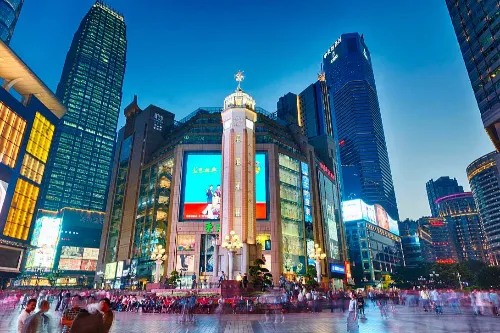
Chongqing Guotai Art Center
It consists of two venues: the Tai Da Theater and the Chongqing Art Museum. The Tai Da Theater is composed of a medium-sized theater with 800 seats and two auditoriums with 350 seats each. The Chongqing Art Museum is positioned at a medium scale, undertaking exhibitions of domestic and foreign arts and crafts, and holding various cultural and artistic exchange activities.
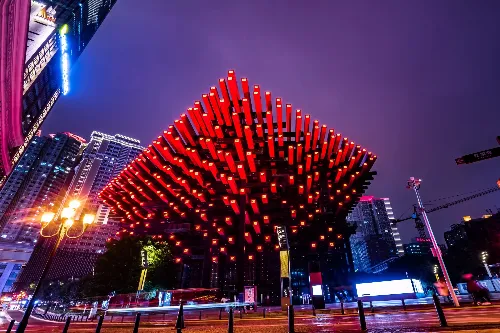
Chongqing World Financial Center
It is a comprehensive building integrating office, commerce, catering and sightseeing, with a total area of 204,600 square meters and a height of 339 meters. It consists of a 70-story Grade A office building and a 9-story commercial podium.
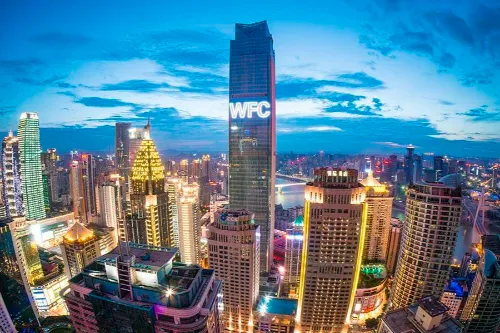
Bayi Road Food Street
It gathers hundreds of kinds of Chongqing characteristic snacks. On the pedestrian street, there are also sculptures of Bayi Road Food Street created by professors from Sichuan Fine Arts Institute. These sculptures have become the symbol of Bayi Road Food Street and are also the earliest urban sculpture works appearing in commercial pedestrian streets in Chongqing.

Chongqing Times Square
Located in the core area of Jiefangbei business district, Chongqing Times Square covers a construction area of about 120,000 square meters. It is a high-end shopping center integrating shopping, catering and entertainment. The square has many international well-known brands and local characteristic merchants. With a modern and fashionable architectural style, it is one of the representatives of modern commerce in Chongqing and an important choice for tourists to shop and relax.

Jiaochangkou Night Market
Jiaochangkou Night Market is adjacent to Jiefangbei Pedestrian Street, with a total area of about 12,000 square meters. It is one of the famous night markets in Chongqing. The night market covers various business forms such as snacks, accessories, clothing and entertainment. It opens every evening until late at night, full of strong market atmosphere. It is not only a good place for tourists to experience Chongqing's night life, but also a popular place for local young people to relax and gather.
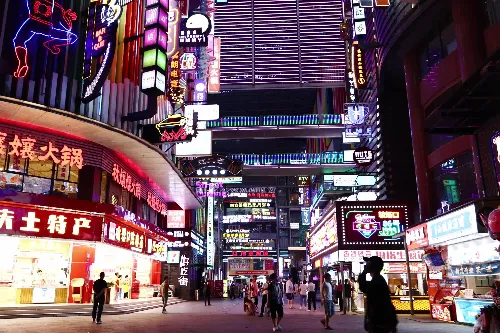
Baixiang Street
Located between Wanglongmen and Taipingmen in Yuzhong District, Chongqing, it is one of the oldest streets in Chongqing. It got its name in the Tang and Song Dynasties, when there was a white marble stone elephant sculpture here, which faced the blue stone lion on the south bank, corresponding to the saying "Blue Lion and White Elephant Lock the Great River". It integrates various business forms such as food, art and cultural and creative industries. On the basis of retaining historical and cultural sites, it is rearranged in the style of the Republic of China, telling the profound story of "One Baixiang Street, Half of Chongqing's History" and showing the charm of the old mountain city and the new look of urban development.
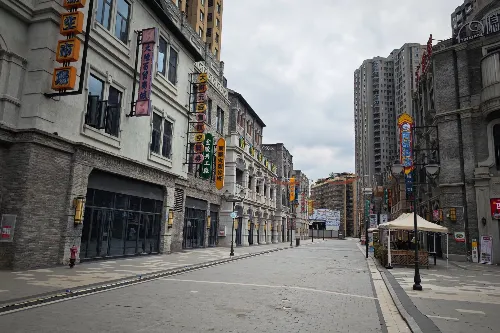
Bombing Massacre Site
Chongqing Bombing Massacre Site has 3 floors with a total construction area of 1,181 square meters. It is a museum transformed from an air-raid shelter, a first batch of national-level anti-war sites, a cultural relics protection unit in Chongqing, and a powerful witness to the major historical events of the Chinese People's War of Resistance against Japanese Aggression and the World Anti-Fascist War.
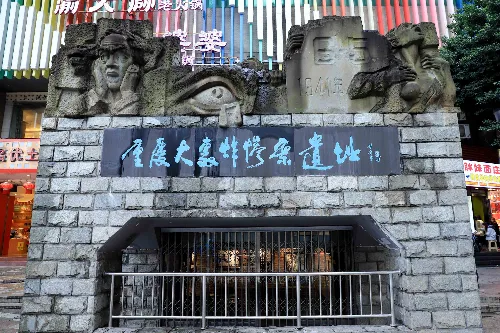
Tour Route
Tourists can start from Jiefangbei Metro Station, first go to the People's Liberation Monument, visit and take photos, and learn about its historical background, which takes about 30 minutes. Then walk along Minzu Road to Chongqing Times Square to experience the modern commercial atmosphere and visit brand stores, which takes about 1-2 hours. At noon, you can go to Bayi Road Food Street to taste Chongqing snacks, and the dining time is about 1 hour. In the afternoon, walk along Bayi Road to Jiaochangkou Night Market to feel the lively atmosphere in advance and visit characteristic small shops, which takes about 1.5 hours. In the evening, return to the vicinity of Jiefangbei to enjoy the night view and feel the prosperity of the night. If time permits, you can watch street performers. The total playing time is about 6-8 hours. If you are interested in historical buildings, you can walk to the surrounding old sites of Republic of China buildings after visiting Jiefangbei, adding about 1 hour of visiting time.
Travel Suggestions
- The playing time can be adjusted according to personal interests and time arrangements, usually about 1-3 hours. If you want to carefully visit the surrounding attractions, you can arrange a whole day.
- The best time to visit is in spring and autumn (March-May, September-November), when the temperature in Chongqing is pleasant, with an average temperature between 15-25℃, suitable for outdoor activities.
- If you want to avoid the peak flow of people, it is recommended to go on weekdays. The number of visitors is large on weekends and holidays, especially during 10:00-22:00.
- When tasting food, you can choose old shops on Bayi Road Food Street, such as "Haoyoulai Hot and Sour Noodles" and "Shancheng Small Glutinous Rice Balls", to experience more authentic flavors.
- The pedestrian street around Jiefangbei is large, so it is recommended to wear comfortable sports shoes. The daily walking distance is about 3-5 kilometers.
- The night view of Jiefangbei is unique. It is recommended to watch it during 19:00-21:00, when the lights are bright and the atmosphere is strong.
- If you need to shop, you can pay attention to the promotional activities of major shopping malls, especially during holidays, when the discount is large.
Matters Needing Attention
- In crowded places such as Bayi Road Food Street, take good care of personal belongings and pay attention to personal safety.
- When tasting food, pay attention to food hygiene, and avoid buying and eating unclean food to avoid physical discomfort.
- When visiting historical and cultural attractions such as the Bombing Site, keep quiet and respect history and cultural relics.
- The flow of people in Jiefangbei Pedestrian Street is large, so take good care of personal belongings, especially in crowded food streets, shopping malls and other areas, and beware of pickpockets.
- The temperature in Chongqing is high in summer (average 30-35℃) and the humidity is high. It is necessary to take heatstroke prevention measures, such as carrying sun umbrellas, sunscreen, drinking water, etc.
- When dining in night markets and food streets, choose stalls with better hygiene conditions to avoid gastrointestinal discomfort caused by eating unclean food.
- Abide by traffic rules. There are many vehicles in some areas around the pedestrian street. Cross the road via zebra crossings and pay attention to passing vehicles.
- Respect local customs and habits, and keep solemn in memorial places such as monuments. Do not make loud noises or chase and fight.
- Some shops may support cash and mobile payment, but it is recommended to carry a small amount of cash for emergencies.
Transportation
- Metro: Take Chongqing Rail Transit Line 1 or Line 2 to "Jiaochangkou Station", walk about 500 meters to reach Jiefangbei Pedestrian Street; or take Line 6 to "Xiaoshizi Station", walk about 800 meters to reach.
- Bus: Many bus routes can directly reach Jiefangbei, such as Route 105, 301, 462, 0491, etc. Get off at "Jiefangbei Station". The bus fare starts at 2 yuan.
- Taxi: The starting fare of Chongqing taxis is 10 yuan (within 3 kilometers). After exceeding 3 kilometers, it is 2 yuan per kilometer. It is about 15 kilometers from Chongqing North Railway Station to Jiefangbei, with a cost of about 35-45 yuan; it is about 25 kilometers from Chongqing Jiangbei International Airport to Jiefangbei, with a cost of about 60-80 yuan.
- Walking: The surrounding area of Jiefangbei is relatively concentrated, suitable for walking tours. The walking distance between attractions is mostly within 1 kilometer.
Opening Hours
Jiefangbei Pedestrian Street is an open block and is open to the public 24 hours a day. Among them, the People's Liberation Monument area is accessible around the clock; Bayi Road Food Street usually operates from 10:00 to 22:00; shopping centers such as Chongqing Times Square are mostly open from 10:00 to 22:00; and Jiaochangkou Night Market is open from 17:00 to 1:00 a.m. the next day. The business hours of specific shops and attractions may vary slightly, and are subject to the actual situation on site.
Tickets
Jiefangbei Pedestrian Street and the People's Liberation Monument are free open areas, and tourists can enter for free. The surrounding shopping malls, food streets and other places also do not require tickets, and only the corresponding fees are paid when consuming. Some characteristic experience projects may require separate tickets, and the specific ticket prices are subject to on-site announcement.
Online Booking
Click here to jump to the Trip.com ticketing platform for ticket purchase.


